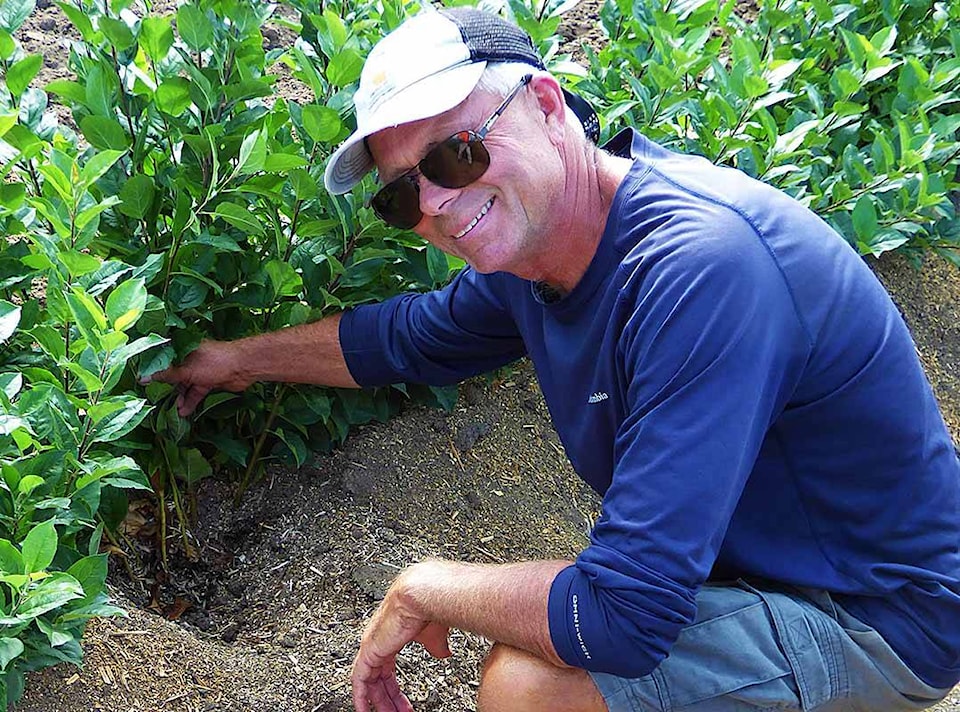I would like to tell you an origins story, not one about X-men or superheroes, but an interesting tale nonetheless.
It’s about colonnade apples and one of the persons responsible for their very existence, a fellow named Doug De Jong.
He isn’t a superhero per se, but he does have what I consider to be superpowers, in that he is a man possessed with a ‘green thumb’ (not to be confused with the Green Hornet).
How also owns and manages Misty Meadows Nursery in Surrey, which has been providing me with quality fruit and shade trees for about 20 years now.
The story begins in 1961 as a single branch mutation that occurred on a 50-year-old ‘MacIntosh’ apple tree in a north Kelowna orchard. This branch produced no side shoots, but was covered with short fruit spurs from top to bottom.
It was vegetatively propagated in order to create the original columnar apple, ‘Wijcik’.
The development of this apple sport was then taken over by the Summerland Research Station, where Doug worked from 1986-91 on behalf of the B.C. Fruit Growers Association.
David Lane, the chief plant breeder there, once asked Doug if he had any suggestions for apple crosses and he proposed the disease resistant crabapples ‘Makamik’ and ‘Thunderchild’.
Some 3,000 crosses later (keep in mind that only 25 per cent of the progeny produced the dwarf genetic mutation) and the research station thought it was ready to start trialing their hybrids in the real world.
Since Doug managed the budwood orchard for his last two summers and was starting his own nursery in the Fraser Valley, he took 50 of the best crosses to graft, grow and evaluate for five years.
While all cropped quite heavily at maturity, they varied widely in terms of disease resistance (many suffered defoliation from scab while others were pristine), fruit quality and size, flavour and growth habits.
The goal was to produce a compact, disease resistant apple tree that could be grown in smaller urban landscapes or large containers.
Finally in 1996, two columnar forms were chosen for release and were appropriately named as ‘Golden Sentinel’ and ‘Scarlet Sentinel’. These mature at about 2.5-metres high and a metre wide (slightly smaller in containers), with one having ‘Golden Delicious’-type apples and the other ‘Idared’ – both being excellent for fresh eating.
But the story doesn’t end there, as many hybrids from Summerland were also shipped to the U.K., where they also managed to produce and release several new columnar apple cultivars.
Doug also talked his friend Wilbert Ronald of Jeffries Nurseries in Portage la Prairie into trialing some of these crosses in the colder Manitoba winters, with two columnar crabapples (remember his earlier breeding suggestions) eventually being selected for introduction.
Both EMERALD SPIRE (‘Jefgreen’) and PURPLE SPIRE (‘Jefspire’) were released with the cooperation of the rights holder, Bylands Nurseries of West Kelowna. I placed a couple of these in the entrance arbor of the nursery where I work just to see what people would think of them, within days all the ripened crabapples had been surreptitiously harvested by passers-by.
As far as the aforementioned ‘Golden Sentinel’ and ‘Scarlet Sentinel’ cultivars are concerned, I can personally vouch for them as I have had the latter in a container for eight years now and it produces great apples.
It has grown to about two m high and 60-centimetres wide, and since we added the ‘Golden Sentinel’ about four years ago, the cross-pollination has allowed for better production – and for that we can all say thanks to my friend, Doug De Jong.
Mike Lascelle is a local
nursery manager and
gardening author
(hebe_acer@hotmail.com).
